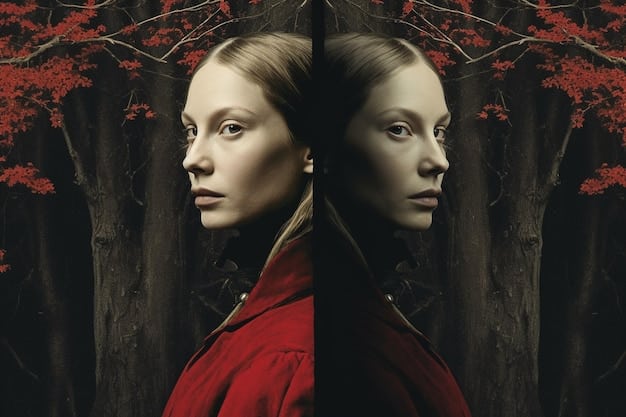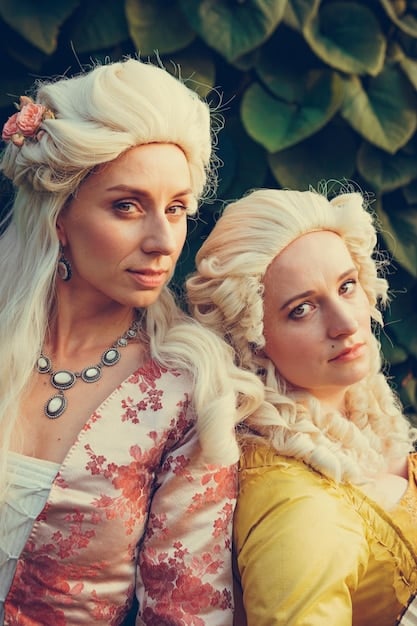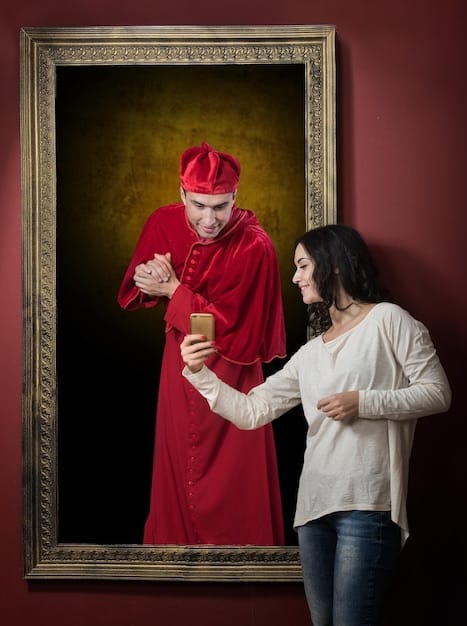The Evolution of Female Characters in Period Dramas: A 2025 Perspective

The Evolution of Female Characters in Period Piece Dramas: A 2025 Examination of Representation explores how representation of women in historical dramas has shifted, reflecting societal changes and offering more complex, empowered roles beyond traditional stereotypes.
Period piece dramas have always offered a glimpse into the past, but **the evolution of female characters in period piece dramas: A 2025 examination of representation** shows a significant shift in how these characters are portrayed. From damsels in distress to complex, empowered women, the journey reflects changing societal values and offers a richer, more nuanced viewing experience.
Understanding the Historical Context of Female Roles
To truly appreciate the evolution, it’s crucial to understand the historical context that initially shaped female roles in period dramas. These depictions often mirrored the prevailing social norms and expectations of the time, highlighting the limitations and constraints women faced.
Early portrayals frequently centered on themes of marriage, domesticity, and social standing. Women were often depicted as passive figures whose lives revolved around securing a suitable match and maintaining their household. Stories rarely explored their inner lives or ambitions beyond the domestic sphere.
Common Tropes in Early Period Dramas
Before diving into the present, its important to understand the origins this media stems from.
- The Damsel in Distress: A classic trope where women are portrayed as helpless and reliant on male rescue.
- The Virtuous Wife: Characters defined by their piety, obedience, and dedication to their husbands.
- The Scheming Socialite: Women who use manipulation and cunning to navigate the social ladder.

These early portrayals, while reflective of their time, often lacked depth and agency for female characters. They served primarily as supporting roles in narratives driven by male protagonists, reinforcing traditional gender roles.
The Rise of Complex Female Leads
A significant turning point in the evolution of female characters came with a growing demand for more nuanced and realistic portrayals. This shift coincided with broader social movements advocating for women’s rights and challenging traditional gender stereotypes.
Modern period dramas began to explore the inner lives and psychological complexities of female characters. They showcased women with diverse motivations, flaws, and ambitions beyond marriage and motherhood. Stories started to delve into their struggles against societal constraints, their pursuit of knowledge and independence, and their contributions to history.
Key Characteristics of Modern Female Characters
Breaking free from restrictive stereotypes, recent female characters are defined by these main aspects:
- Agency: Women taking control of their destinies and making independent choices.
- Ambition: Characters pursuing their personal and professional goals with passion and determination.
- Resilience: Women overcoming adversity and challenging social norms with strength and courage.
This evolution has led to more compelling and relatable characters who resonate with modern audiences. These women are not simply defined by their relationships or their appearance but by their intelligence, their spirit, and their contributions to the world around them.
Examples of Empowered Female Characters
Several recent period dramas have showcased the rise of empowered female characters who defy traditional expectations and challenge historical narratives. These portrayals offer fresh perspectives on the past and inspire audiences with their courage and determination.
Shows like “Queen’s Gambit,” “Bridgerton,” and “Gentleman Jack” have featured complex female leads who navigate political intrigue, social expectations, and personal desires with intelligence and agency. They are not simply victims of circumstance but active agents of change.

Series that Exemplify Female Empowerment
There are three shows that stand out in particular.
- “Queen’s Gambit”: Beth Harmon’s journey as a chess prodigy in the 1960s defies gender expectations in a male-dominated field.
- “Bridgerton”: The series explores the lives of strong-willed women navigating the marriage market in Regency-era England, showcasing their desires and ambitions beyond societal expectations.
- “Gentleman Jack”: Anne Lister’s unapologetic portrayal of her lesbian relationships and her business acumen in the 19th century challenges traditional gender roles and celebrates female independence.
These examples demonstrate how period dramas can be used to explore complex issues of gender, power, and identity. By showcasing empowered female characters, these shows offer a more inclusive and nuanced understanding of history.
The Impact on Audience Perception
The evolution of female characters in period dramas has had a profound impact on audience perception of women in history and the present. These portrayals challenge traditional stereotypes and offer more relatable and aspirational role models.
By showcasing women with agency, ambition, and resilience, period dramas can inspire viewers to question gender norms and pursue their own goals. They can also promote greater empathy and understanding for the struggles and triumphs of women throughout history.
Benefits on Audience Perception
The effects are measurable and important.
- Challenging Stereotypes: Offering diverse portrayals of women beyond traditional tropes.
- Promoting Empathy: Fostering understanding and appreciation for women’s experiences.
- Inspiring Empowerment: Encouraging viewers to pursue their own ambitions and challenge limitations.
Furthermore, period dramas can contribute to a more inclusive and equitable society by celebrating the contributions of women throughout history and promoting gender equality in the present.
The Role of Representation in Shaping Narratives
Representation plays a crucial role in shaping narratives and influencing how viewers perceive the world. The evolution of female characters in period dramas is a testament to the power of representation in challenging stereotypes and promoting social change.
When diverse voices and perspectives are included in storytelling, it creates a more accurate and nuanced understanding of history and the human experience. Representation can also empower marginalized communities and inspire them to pursue their dreams.
Examples of Progressive Representation
Progressive representation looks like the following ideas enacted:
- Diverse Casting: Featuring actors of different ethnicities, sexual orientations, and abilities.
- Authentic Storytelling: Collaborating with historians and cultural consultants to ensure accuracy and sensitivity.
- Challenging Tropes: Avoiding harmful stereotypes and promoting positive representations.
As audiences become more diverse and demanding, the need for authentic representation in period dramas will continue to grow. By embracing diversity and inclusion, these shows can contribute to a more equitable and just society.
Future Trends in Female Character Development
There are expectations to where the storytelling may trend in the future.
Looking ahead, the evolution of female characters in period dramas is likely to continue, with even greater emphasis on authenticity, diversity, and empowerment. Future trends may include:
More nuanced portrayals of intersectional identities, exploring the experiences of women who face multiple forms of oppression, such as race, class, and sexual orientation. Greater collaboration with historians and cultural consultants to ensure accurate and sensitive depictions of historical events and social contexts.
Future Trends Might Include
- Intersectional Storytelling: Stories that will address various forms of oppression that women face.
- Authentic Collaboration: Working with historians in order to ensure the accuracy of storytelling.
- Technological Integration: Future shows integrating technology into historical narrations.
The integration of technology to enhance the storytelling experience, such as virtual reality and augmented reality, allowing viewers to immerse themselves in historical settings and interact with female characters in new ways. The future of female characters in period dramas is bright, with endless opportunities to explore the complexities of the past and inspire a more equitable future.
| Key Point | Brief Description |
|---|---|
| 👩💼 Early Roles | Often depicted women as passive, focused on marriage and domestic life. |
| ⬆️ Evolution | Modern dramas showcase complex, empowered women challenging norms. |
| 🌟 Key Examples | “Queen’s Gambit,” “Bridgerton,” and “Gentleman Jack” empower female leads. |
| 🔮 Future Trends | Increased authenticity, diversity, and intersectional storytelling. |
FAQ
▼
Originally, women were presented as very passive characters, without goals or aspirations of their own. Modern period dramas are moving towards character development of the female lead.
▼
“Queen’s Gambit, “Bridgerton,” and “Gentleman Jack” are all great examples. With a woman taking charge and pushing to break the mold for what women can do.
▼
Representation helps shape views and shows people in a meaningful and accurate way. Without it, people’s opinions or views on certain topics become skewed or inaccurate.
▼
There is an expectation that more characters across the LGBTQ spectrum will join the media and other characters that share intersectional identities. This will give a more realistic expectation and view of history.
▼
They offer a glimpse into the past and a reflection of how much society has changed. By showing empowered female characters, they inspire others to break the mold and rise against expectations.
Conclusion
The evolution of female characters in period piece dramas reflects a broader societal shift towards gender equality and inclusivity. As these dramas continue to evolve, they have the potential to shape perceptions, inspire change, and offer a more nuanced understanding of history through the lens of strong, empowered women.





